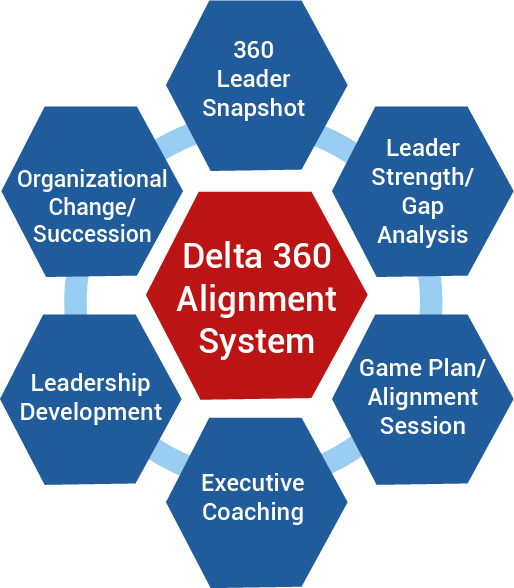The process of alignment in most organizations today is episodic and often crisis-driven, rather than an organizational strategy. Organizations must embrace a system of aligning and coaching their top talent as a business strategy.
How are business teams and sports teams alike?
“Well actually, they’re not alike in any way,” a casual observer might say. Looking at the graphic above, at first glance you’d agree they have little if anything in common.”
The central way in which sports teams and business teams are alike is they’re both aligned … but in very different ways for two very different reasons. Sports teams align around a single goal—to score and to win.
Business teams are aligned around generating revenue and profits for companies, but in a way that is indirect and often lengthy and many of the team members have no idea when or if the organization scores.
Business Teams—How Would You Know One if You Saw One?
Business teams don’t look like teams at all if you look at the people. You might not know that the folks around the table in the graphic above were a team unless someone told you. They could be a group of attorneys meeting to negotiate a lawsuit. They might be a synagogue/church committee, a collectors club, or a non-profit board.
People on business teams don’t suit up in team jerseys. The team in the photo looks a bit upscale in the way they dress compared to here in Austin, Texas (our standard dress is artfully worn-out denims and nondescript shirts bought used on Congress Avenue).
Sitting around the table, this team seems to be looking at someone presenting, but there are different tools—computers, paper, pencil, paper calendars, cell phones—and different levels of attention. They seem to be together at a meeting with the aim of getting out and going about their real business.
Sports Teams—the Ultimate Alignment
On the other hand, sports teams live alignment. Their days are consumed around learning the playbook by memory, practicing, running plays, and building a defense based around their best espionage of what the other team will do. They know the score moment by moment and their win/loss record.
Aligning Business Teams Like Sports Teams
But that’s most often not true of business teams. Are business teams really teams? Why do we call them teams in the first place?
Before the 90s, subgroups within organizations were called departments. In those days departments sat in the same areas of the building and were supervised by the department head. There were procedures that spelled out when, how, and who would approve the actions of employees. I knew of a utility where muli-signatures were required to write and send a letter.
When computers became a part of every process in organizations, business became fluid. Processes moved at the speed of light and slow-moving departments became impossible Emails crisscrossed from HR to accounting, to customers in totally organic and unpredictable ways.
So we stopped calling subgroups departments—we renamed them all teams. But are most of them really teams? The members may only sporadically work together. And they may not know how the team wins the game.
Most business teams are not aligned in the same way that sports organizations are aligned. Organizations are stuck somewhere between traditional hierarchical departments and something akin to sports teams.
Alignment is the “Piece Missing”
Alignment is the piece missing that keeps organizations from running at the speed of 21st Century technology. Our technology is the state of art, but human team process is stuck in the 20th Century. We have little sense of how to utilize the science of human performance that modern sports lives by.
Sports teams serve as a model for 21st Century organizations because they are in the process of aligning—and realigning game after game. They know where the goal is and everything they do is geared to win the game.
Here are some aspects of sports model that are critical for business teams.
- A Culture of Constant Professional Coaching – Organizations pay search companies enormous amounts to find top talent, but think that coaching and the alignment process are too expensive and time consuming. Business leaders can be quite suspicious of alignment processes. Their take on coaching and mentoring their star players can be taking them out for a beer once in a while—or giving them the latest book on mentoring, hoping they will use it with their people.
Can you imagine a sports team investing $20 million over a 5-year period on a player that they expect to be a key factor in winning a national championship—yet not providing the best coaches in the league?
The process of alignment in most organizations today is episodic and often crisis driven, rather than an organizational strategy. Organizations must embrace a system of aligning and coaching their top talent. - Videotaping the Game. In sports teams there is the video of the last game it played. Improving performance depends on reviewing successful plays that took the team forward, as well as the times we dropped the ball—it’s all there plainly shown on the tape and can’t be denied.
A similar tool for organizations is the 360-degree assessment. The best way to display how you did is from the perspective of the professionals whom you work with, your boss, your peers, and your direct reports. For the first time you get a solid picture of how people scored or missed opportunities. You can’t improve without realtime feedback. - Putting Together the Playbook. As the 360-degree assessment is the videotape of your latest game, the GamePlan is the playbook for a leadership team. It takes the data from the 360-degree assessment, and creates a playbook to move forward. It takes the guesswork out of what you’ll do next and makes what you’ll do part of the team GamePlan. It is the best tool a team can have to positively reinforce each other.
- Running Plays. Running plays in practice lets you know if they will work in the game, but there is little to no provision for a business team to run plays. Alignment sessions provide the opportunity to do what sports teams do—run plays before you get into the game to see how they work.
It is stunning how many resources that organizations pour into business processes—recruiting, sales and marketing, payroll, accounting, HR, legal, and all the rest. No one with an ounce of sanity would question that any of these processes are necessary. Yet leaders can be totally allergic to spending time and resources on alignment initiatives, although the ROI is better than most investments in an organization.
Leaders, in fact, have every reason to be suspicious of alignment initiatives because they can and have been a time and money sink in the past. Delta, Inc. has developed the Delta 360 Alignment System that has made huge impacts on organizations. We are certainly not the only organization that helps organizations achieve alignment, but we urge you to become aligned as an organization. Becoming aligned is the missing piece for organizations.







